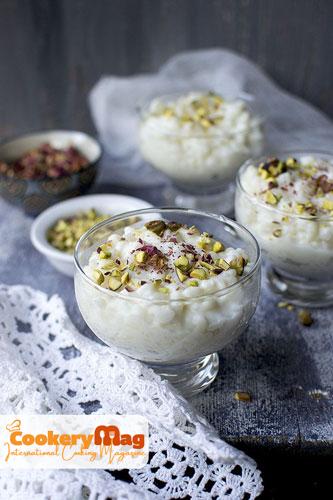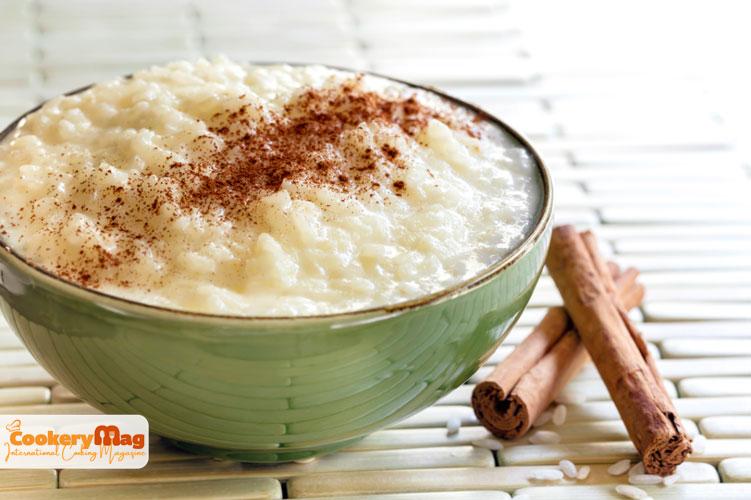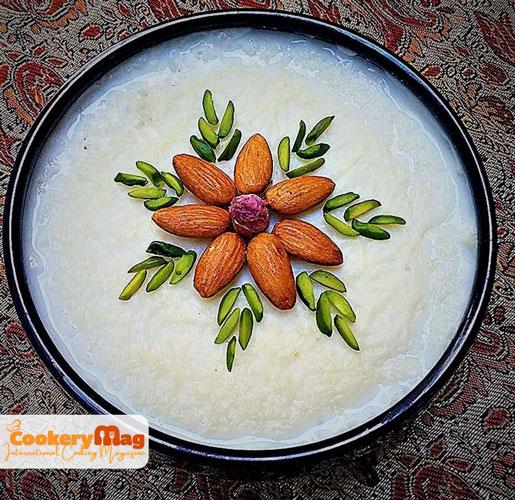© All Rights Reserved.
Shir Berenj Recipe, comparing 2 Adorable Rice Pudding types, Persian and Afghan
If you have children growing up, they will love Shir Berenj or Persian Rice Pudding. The creamy consistency of the rice grains is simply divine.
Whether you call this rice pudding, sheer berenj, or rooz bil haleeb- one this is sure the pudding is a common favorite in many cultures. Iranian people especially enjoy preparing during Ramadan for suhoor. It is simply a delicious recipe told in this article in Cookery Magazine that can be enjoyed on its own or paired with your favorite variations.

There are two theories about the history of this simple dessert. The first theory says that the origin of Shir Berenj goes back to China and East Asian countries. But the second theory, which is more valid, states that the cooking of Shir Berenj started in India.
The method of preparing Shir Berenj has traveled from Asian countries to other continents and has changed too much.
Southeast Asia is known as the derivation for the strange flavors of Shir Berenj because the recipe for rice
pudding is completely exclusive in these countries.
Since India is one of the major centers of rice and sugarcane production, this hypothesis is strengthened that the origin of cooking rice milk is in India.
Also, according to the research, the root of milk rice dates back to 6000 years before Christ.
According to historical information, rice pudding was prescribed as a diet for Indian kings by a doctor called Ayurveda.

Therefore, in India, Shir Berenj is also called the royal dessert. It is first mentioned in the epics Mahabharata and Ramayana as ksheer or kshirika in Sanskrit, which translates to a dish made with milk.
After years passed, and with people’s awareness of the properties of Shir Berenj, in 1920, the cooking of this simple and delicious dessert spread worldwide and became a popular dessert worldwide.
But nowadays, Shir Berenj is cooked in different ways in many countries. Shir Berenj is a hearty and delicious dessert served both hot and cold.
It can be considered a complete food because it contains compounds such as proteins, vitamins (especially vitamin B family), and minerals.
In most countries, especially European this delicious dish is called “rice pudding” and has countless fans worldwide.
Shir berenj or Shirba is a type of Brunch that is prepared from milk and rice and is mostly eaten with sugar and syrup, and it is also called “Ash Shir (milk soup)”.
Shir berenj is a dessert, but some call it soup.
In Mazandaran, a ceremony is called Tamanai Baran (wishing for rain).
In one of its rituals, all the villagers collect milk and rice and use it to make Shir berenj, eat it, and pour some of it on the roof, believing it will rain.
Shir berenj is useful because it contains milk (a rich source of calcium), like doogh, as I mentioned in the previous article, and rice (rich in group B vitamins), as well as tonic and soothing flavorings such as cardamom and rose water.
Traditional Chinese shir berenj called “Ba Bao” is prepared with sugar syrup, nuts and fruits, red beans, and meat for the New Year ceremony.
In Indonesia, black rice pudding is cooked and served.
In the Philippines and Thailand, “Chocolate and Banana Rice Pudding” has many fans.
However, the recipe for cooking “orange Rice Pudding” is very popular in Spain and has also traveled to South America.
In general, it should be known that the common base of all Rice Pudding recipes includes “cooked and sticky rice, milk and sugar”, which according to the traditions and tastes of people in different geographical regions, other things are added to it so that cooking in different climates can evolve.
The difference between Afghan and Iranian rice pudding is that Afghan Sheer Berenj often uses short-grain rice, while Iranian Sheer Berenj typically uses long-grain rice.
Using rosewater, cinnamon, pistachios, and cardamom is based on your taste, and we can’t say for sure which one is originally for which country.
Using saffron, we turn shir berenj to Shole Zard, which I have given the recipe for in previous articles.
So the use of saffron makes this recipe unique to Afghanistan.
It is going to be said that The way to serve milk rice in Afghanistan is warm or at the same temperature as the environment and room, But in Iran, it is mostly served cold.
Ingredients for making Shir Berenj (Persian/ Afghan rice pudding) :
| basmati rice | 1 cup |
| water | 6 cups |
| salt | as needed |
| milk | 4 cups |
| sugar | ¼ cup |
| orange blossom essence | 1teaspoon |
| slivered pistachio | ½ cup |
Recipes to make Shir Berenj (Persian/ Afghan rice pudding):
You must start by washing and then soaking your rice for at least 1 hour. You can either use long-grain basmati rice or short-calorie rice. Drain the rice after soaking for about an hour. Give it a little rinse.
In a large pot, add your rice, pour 6 cups of water, add a pinch of salt, then allow the rice to cook for about 20 to 30 minutes on medium heat until the liquid begins to reduce and don’t forget to stir every so often so that no rice sticks to the bottom.
When the water evaporates, add your milk and let it continue boiling. Stir the mixture from time to time until the liquid reduces.
Add in sugar and vanilla essence once most of the milk has been reduced. You can also use orange blossom or rose water instead. Allow your Shir Berenj or rice pudding to simmer for 10 to 15 minutes.
Serving Shir Berenj:

Now, Your Shir Berenj is ready to serve. You can serve it in small cups, perfect for a single portion. Garnish the Shir Berenj with some ground pistachio and rose petals for an extra kick of color.
Conclusion:
I hope you guys like this recipe. Don’t forget to tell us your experience of cooking Shir Berenj and also your other recommendations❤️
Frequently Asked Questions:
What are the benefits of rice pudding, and what is this food good for?
1. Increasing life expectancy and body immunity
2. Relieve fatigue and increase energy
3. easy digestion
4. Useful for skin health
5. fattening thin people
6. Good for the heart
7. suitable food for children

